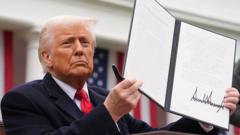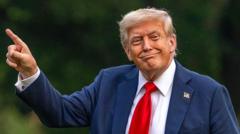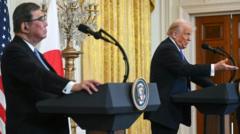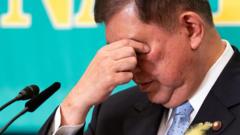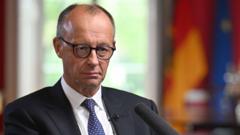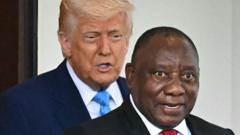In a significant development in global trade, negotiations between the U.S. and the E.U. have taken center stage, driven by recent tariff delays announced by President Trump. The unfolding scenario highlights both the complexities and the potential for resolution in international trade.
U.S. and E.U. Trade Talks Intensify Amid New Tariff Delays

U.S. and E.U. Trade Talks Intensify Amid New Tariff Delays
Negotiations commence as both sides aim for a compromise while navigating differing priorities.
As of yesterday, E.U. Trade Commissioner Maros Sefcovic engaged in discussions with U.S. Commerce Secretary Howard Lutnick following Trump’s announcement of a 50 percent delay on all E.U. imports. This suspension aims to foster a more conducive environment for negotiations, which are expected to continue as leaders strive for a compromise ahead of the new July 9 deadline for tariffs.
Expressing the E.U.’s commitment to constructive dialogue, Sefcovic's remarks on social media reaffirm that both sides are focusing on arriving at a feasible deal. The upcoming discussions also included a phone call on Sunday between Trump and European Commission President Ursula von der Leyen, which reportedly injected fresh momentum into the negotiations, as indicated by the commission's spokeswoman, Paula Pinho.
Despite the optimism, the road to an agreement presents significant challenges, predominantly due to diverging priorities between the two regions. While the E.U. is advocating for mutual tariff reductions on industrial goods, they are also in the process of refining lists of proposed retaliatory tariffs targeting American goods, including machinery, soybeans, and bourbon.
On the other hand, the Trump administration is pushing for sweeping changes within the E.U.’s consumption tax framework and digital regulations – a demand that European officials have indicated they are unlikely to accommodate. This hesitation underscores the ongoing tensions that could impede progress during the impending negotiations.
As discussions move forward, observers are closely watching to see if the two economic powerhouses can bridge their differences in pursuit of a balanced trade agreement, amidst a backdrop of ongoing economic uncertainty and shifting international relations.
Expressing the E.U.’s commitment to constructive dialogue, Sefcovic's remarks on social media reaffirm that both sides are focusing on arriving at a feasible deal. The upcoming discussions also included a phone call on Sunday between Trump and European Commission President Ursula von der Leyen, which reportedly injected fresh momentum into the negotiations, as indicated by the commission's spokeswoman, Paula Pinho.
Despite the optimism, the road to an agreement presents significant challenges, predominantly due to diverging priorities between the two regions. While the E.U. is advocating for mutual tariff reductions on industrial goods, they are also in the process of refining lists of proposed retaliatory tariffs targeting American goods, including machinery, soybeans, and bourbon.
On the other hand, the Trump administration is pushing for sweeping changes within the E.U.’s consumption tax framework and digital regulations – a demand that European officials have indicated they are unlikely to accommodate. This hesitation underscores the ongoing tensions that could impede progress during the impending negotiations.
As discussions move forward, observers are closely watching to see if the two economic powerhouses can bridge their differences in pursuit of a balanced trade agreement, amidst a backdrop of ongoing economic uncertainty and shifting international relations.






